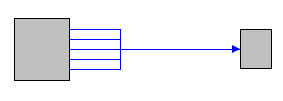Normal links ( IlvLinkImage) can be incident to one node at
most twice: if the link is a self-loop, that is, if the source and
target of the link is the same node, then the link will occur in
the list of incident links at the node twice. Both ends of the link
are easily distinguishable, because one is the source end and the
other is the target end.
Not only can a hyperedge ( IlvHyperEdge) have multiple end nodes, but it
can also have multiple ends at the same node. Therefore this link
is incident to the node multiple times. For example, if you call addFrom multiple times for the same node at
the same hyperedge, this hyperedge will have multiple source ends
at that node. See the following figure.

Multiple ends at the same node
How can you distinguish the different ends
of the hyperedge at the node?
The interface IlvHyperEdgeEnd serves as the end indicator
of a hyperedge. Instances of this interface are called the
hyperedge ends. The default implementation is IlvDefaultHyperEdgeEnd.
The hyperedge ends technically belong to
the hyperedge and not to the node. They point to the end node.
If a source or target node is added to the
hyperedge, a new hyperedge end is created internally and connects
the hyperedge to the node. If the hyperedge is removed from the
hypergraph, all ends of the hyperedge will also be removed.
If a hyperedge connects to one node multiple times, there will be
multiple different instances of
IlvHyperEdgeEnd
stored in the hyperedge. All these instances point to the node.
The hyperedge ends can be distinguished from each other, even
though the corresponding end node is the same.
The following table shows methods included in the API of
IlvHyperEdgeEnd
.
Methods of IlvHyperEdgeEnd
Method |
Description
|
|---|---|
Returns
the hyperedge that contains the specified end. |
|
Returns
the node that is connected to the hyperedge by the end. |
|
Returns the position of the end. The input transformer
indicates the coordinate system (untransformed manager
coordinates or transformed view coordinates if
t
is the transformer for drawing the hyperedge). Usually, you
should pass the value
true
for the flag.
|
|
Sets the
position of the end. |
The following table shows the API of
IlvHyperEdge
in more detail. It explains how the operations influence the
hyperedge ends and which additional API exists for manipulating the
hyperedge ends directly at the hyperedge.
Methods of IlvHyperEdge
API |
Description
|
|---|---|
Creates a new hyperedge end that points to the input node. The
hyperedge end is stored as source in the hyperedge. Finally,
the hyperedge end is returned, so that you can use it to set
the precise position of the hyperedge end. Note that this
modifies the geometry of the hyperedge and therefore must be
encapsulated in an applyToObject session.
|
|
Creates a new hyperedge end that points to the input node. The
hyperedge end is stored as target in the hyperedge. Finally,
the hyperedge end is returned, so that you can use it to set
the precise position of the hyperedge end. Note that this
modifies the geometry of the hyperedge and therefore must be
encapsulated in an
applyToObject
session.
|
|
Collects all source hyperedge ends
that point to the input node. These ends are removed from the
sources of the hyperedge.
|
|
Collects all target hyperedge ends
that point to the input node. These ends are removed from the
targets of the hyperedge.
|
|
Removes one source hyperedge end.
Other hyperedge ends are not affected, even if they point to
the same node.
|
|
Removes one target hyperedge end.
Other hyperedge ends are not affected, even if they point to
the same node.
|
|
Returns
the source nodes of the hyperedge. Each node occurs at the most
once in the enumeration, even if multiple hyperedge ends point
to this node. |
|
Returns
the target nodes of the hyperedge. Each node occurs at the most
once in the enumeration, even if multiple hyperedge ends point
to this node. |
|
Returns
the number of source nodes of the hyperedge. |
|
Returns
the number of target nodes of the hyperedge. |
|
Returns
the source hyperedge ends. |
|
Returns
the target hyperedge ends. |
|
Returns
the number of source hyperedge ends. |
|
Returns
the number of target hyperedge ends. |
As a general rule, when the end nodes are
retrieved or counted, a node occurs once only, even if there are
multiple ends at a node. When the ends are retrieved or counted,
multiple ends that point to the same node occur as distinguishable
items. Therefore, the following equation is true:
edge.getFromCount() <= edge.getFromEndsCount() edge.getToCount() <= edge.getToEndsCount()
Important
You should never remove source nodes or source ends while
iterating over the objects returned by
getFrom()
or
getFromEnds()
.
You should never remove target nodes or target ends while
iterating over the objects returned by
getTo()
or
getToEnds()
.
The class
IlvHyperEdge
has other useful API, such as API for retrieving the ends or end
nodes in an array, which is convenient if you need to remove the
ends, or for checking whether a given end is source or target. See
the reference documentation of IlvHyperEdge for details.